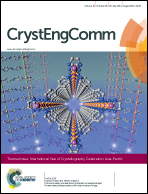A series of metal–organic frameworks based on a semi-rigid bifunctional ligand 5-[(1H-1,2,4-triazol-1-yl)methoxy] isophthalic acid and flexible N-donor bridging ligands†
Abstract
Eight metal–organic frameworks, namely, [Co2(L)2(biim-4)(H2O)2] (1), [Mn2(L)2(biim-4)(H2O)2] (2), [Mn2(L)2(btd)] (3), [Ni2(L)2(biim-4)(H2O)2]·4H2O (4), [Cu2(L)2(biim-4)(H2O)]·2H2O (5), [Cu2(L)2(btd)]·4H2O (6), [Zn2(L)2(biim-4)]·4H2O (7) and [Zn2(L)2(biim-4)]·H2O (8), where H2L = 5-[(1H-1,2,4-triazol-1-yl)methoxy] isophthalic acid, biim-4 = 1,1′-(1,4-butanediyl)bis(imidazole), and btd = 1,10-bis(1,2,4-triazol-1-yl)decane, have been synthesized and characterized. Compounds 1 and 2 are isostructural and display three-dimensional (3D) (4,5)-connected nets with the same (42·64)(42·67·8) topology. Compound 3 possesses a 3D (4,5)-connected framework with (43·63)(43·66·8) topology. Compound 4 shows a two-dimensional (2D) trinodal (3,4)-connected network with a topology of (4·52)2(54·82)(42·52·72) and a vertex symbol of (4·5·5)(5·5·5·5)(4·4·5·5), which is extended by hydrogen bonding interactions into a 3D supramolecular architecture. Compounds 5 and 6 furnish 3D (3,4)-connected nets with (4·6·8)(4·62·83) and (4·82)(4·82·103) topologies, respectively. Compounds 7 and 8 were prepared by using the same raw materials at different temperatures. Compound 7 has a 2D → 3D parallel polycatenation formed through bilayers. Compound 8 features a 3D (3,4)-connected net with (6·102)(62·104) topology. In addition, photoluminescent properties for compounds 7 and 8 are discussed.
![Graphical abstract: A series of metal–organic frameworks based on a semi-rigid bifunctional ligand 5-[(1H-1,2,4-triazol-1-yl)methoxy] isophthalic acid and flexible N-donor bridging ligands](/en/Image/Get?imageInfo.ImageType=GA&imageInfo.ImageIdentifier.ManuscriptID=C3CE42625D&imageInfo.ImageIdentifier.Year=2014)
- This article is part of the themed collection: International Year of Crystallography Celebration: Asia-Pacific

 Please wait while we load your content...
Please wait while we load your content...